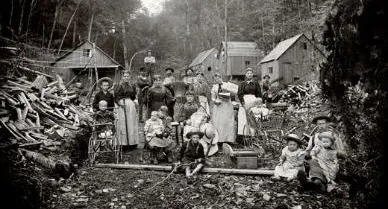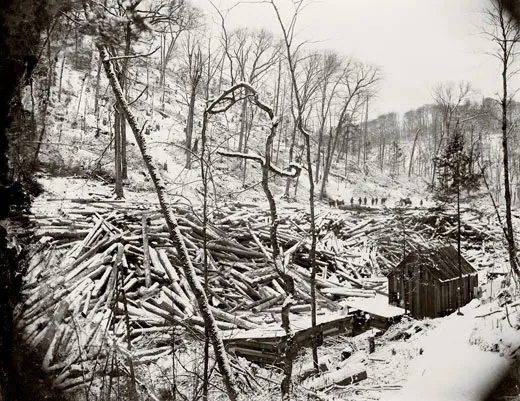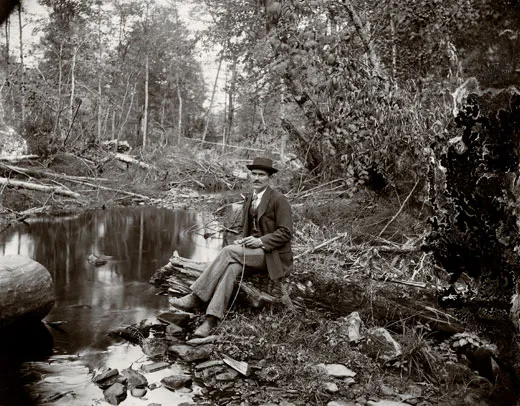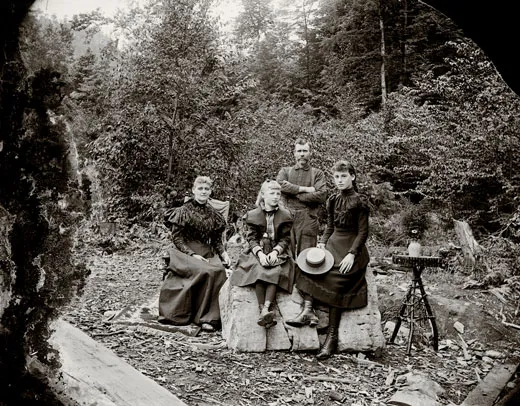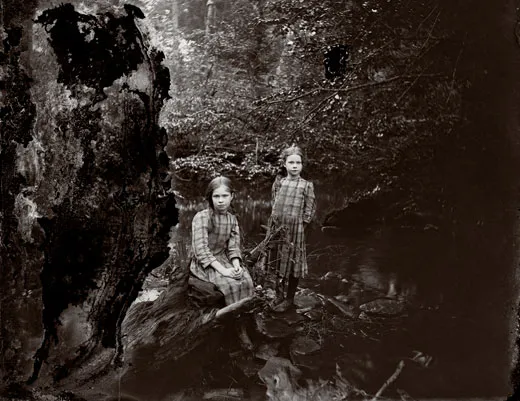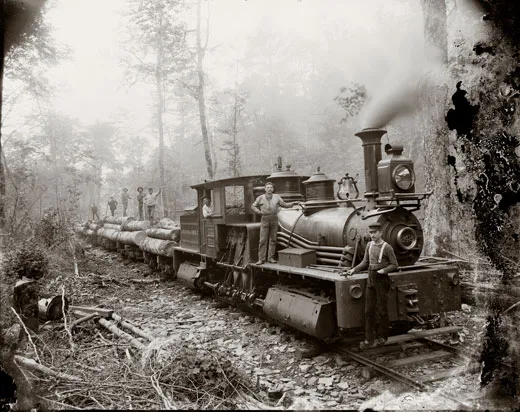Forgotten Forest
Photographic plates discovered in a dusty shed offer an astonishing look at life in the American woods more than a century ago
Lois Barden was rummaging through a toolshed near Rochester, New York, when her eyes fell on a grime-coated crate half hidden in a dark corner. Glancing into it, Barden saw dozens of discarded windowpanes. Or were they? She held one up to the light, squinted at a filthy smudge—and was astonished to see ghostly faces staring back at her. She looked more closely. There were men, women, children and horses in a woodland setting. They were all locked in a shadowy wash of silver nitrate, for what Barden discovered was a trove of old 8x10-inch glass-plate photograph negatives.
That was 1972. Barden, who works as a 911 emergency dispatcher in nearby Ithaca, put the 98 glass plates in her attic. Over the years, she pondered the backwoods photographer, wondering who he was and how his work ended up in a toolshed that had belonged to her husband’s grandmother, Isabel Mayo. In March 2004, Barden, aware of our research on historical photographs, contacted us to help solve the mystery.
When we saw the images, we were stunned by the artful museum-quality work.
Words and dates scratched onto the plates provided the first clues to where and when the photographs were taken: logging camps near Galeton and Port Allegany, in north-central Pennsylvania, in 1897 and 1898. We made prints from the negatives and showed them to Linda A. Ries, of the Pennsylvania State Archives. She recalled similar pictures in the archives, from 1910 to 1915, thought to be the only surviving work by a photographer who traveled the lumber country for years. But most of his works—perhaps thousands of glass plate negatives—were known to have been destroyed in a leaky barn. Ries, delighted that a cache of early pictures might have escaped destruction, identified him as William Townsend Clarke.
So we began combing other archives and local historical societies to learn about Clarke. We found out a good deal from the writings of Henry Wharton Shoemaker, a colorful folklorist who knew Clarke personally. Clarke was born in New York in 1859 of Irish lineage. As a young man, Shoemaker wrote, Clarke abandoned plans to attend Yale College; chronically ill, he took a doctor’s advice to get “rest and outdoor life for a couple of years” and moved to the virgin “Black Forest” of north-central Pennsylvania. Reportedly an enthusiastic photographer since his early youth, Clarke began documenting life in logging communities. He stayed in Betula and Conrad, in north-central Pennsylvania, where he returned periodically to develop negatives and print photographs. He sold “sets of views” to the people he had photographed and earned money from the logging firms that hired him to record their operations. For more than three decades, he wandered like a “Pennsylvania lion or panther, with the manner of an alchemist and voyageur,” Shoemaker wrote, looking “into every nook and unfrequented place, ferreting out queer types of people to take their pictures.”
He photographed rough-and-ready loggers (who called themselves “wood hicks”) and bark strippers (“bark savages”). He also documented their families, tools, animals, living and eating quarters and entertainments. And then, after a ravenous lumber industry had devoured the forests, Clarke captured the devastated, barren countryside that came to be known as the Pennsylvania desert.
Around 1915, Clarke was in Rochester, possibly working for the Eastman Kodak Company. The city was home to Clarke’s sister, brother, two nephews and two nieces, including Isabel Mayo. Clarke, who never married, died in Rochester at age 71 in July 1930. We don’t know why he selected those 98 plates to take north with him; perhaps they were his favorites. We can only marvel that Mayo kept them and that Barden, her granddaughter-in-law, saved them from oblivion.
A documentary photographer, however objective he may be, cannot help but leave traces of his personality in his work. In a typical Clarke photograph, we count a dog, four women, six children, ten horses and 24 men, all attentively regarding the man behind the camera. Thus we surmise that Clarke was exceptionally calm, patient and thorough. His images are generally somber. At the same time they bear occasional touches of whimsy: faces peek from bunkhouse windows; a boy scrambles onto a rooftop to strike a silly pose; a logger playing cards shows his hand to the camera; a dog sits on a chair. Clarke clearly prized order and clarity; he consistently captured many critical details in a single frame: loggers’ faces, camp structures, a railroad and shorn hillsides. He communicated his awe at the scale of logging operations in long-range pictures of “rough-and-tumble” landings piled precariously high with enormous tree trunks, where lumbermen and horses appear dwarfed by the results of their labor.
Among the plates Barden found is one that we believe is a self-portrait; it shows a pensive, well-dressed man beside a stream, holding a branch and striking a self-conscious pose. The picture fits Shoemaker’s description of Clarke as “a corncob pipe-smoking, tall, slight, affable mountaineer, possessing a magnificent soldierly figure and erect carriage, with aquiline features singularly reminiscent of General Pershing.”
Clarke didn’t sign his photographs and only occasionally rubber-stamped his name on the back of a mounted print or stereograph card. He probably didn’t think of himself as an artist, though, as Shoemaker noted, Clarke’s pictures are “gems of art.” If Clarke was aware that 250 miles away in New York City his contemporary Alfred Stieglitz was championing a movement that favored soft and fuzzy painterly effects, Clarke’s sharp images don’t show it. We suspect that Clarke’s motivation was similar to that of the famous Northwest logging photographic team Darius and Tabitha Kinsey: not to create art, but to earn a living by documenting as clearly as possible the people and their work environments.
The evidence from Clarke’s photographs and his few surviving words suggests a man profoundly ambivalent about his subject. His portrayals of the camps convey reverence for the loggers’ skills and hard work. “Everybody who works in the woods has a story about him of some kind, all worth recording,” he once said. “The average lumberman is an original.” But he also depicts a bleak, if epic, transformation of the countryside. There is a bitter sadness to what he has seen. In a letter written in the early 1900s, Clarke laments: “The hill forests are about gone and this is the last of it...the fastest mill ever run in this country is now eating up the trees at a rate of 275,000 to 300,000 [board feet] per 24 hours. Why? When the hemlock can not last there more than 7 or 8 years at most....”
Recently, we went to Pennsylvania and visited some of the places that Clarke photographed. We found a measure of hope; the once denuded hillsides, nurtured by state and federal authorities with an outlook toward sustainability, have regenerated into a luxuriant mix of timber. Little physical evidence remains of the lumber industry’s “hateful blackened fire-swept wastes,” as Shoemaker called them. Indeed, only through Clarke’s eyes do we gain access to that era.
“I will never forget my days in the lumber camps of the Black Forest,” Clarke recalled to Shoemaker in 1923, “especially the long summer evening, when I sat by my cabin door, listening to some husky lad at the camp across the creek, playing ‘The Little Log Cabin in the Lane’ on his melodeon, and watching the girls walk up and down the boardwalk arm in arm. These mental pictures will never grow less, no matter how often the fires sweep over the slashings.”
